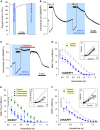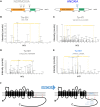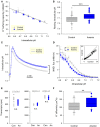Cardiomyocyte Na+/H+ Exchanger-1 Activity Is Reduced in Hypoxia
- PMID: 33585583
- PMCID: PMC7873356
- DOI: 10.3389/fcvm.2020.617038
Cardiomyocyte Na+/H+ Exchanger-1 Activity Is Reduced in Hypoxia
Abstract
Fully-activated Na+/H+ exchanger-1 (NHE1) generates the cardiomyocyte's largest trans-membrane extrusion of H+ ions for an equimolar influx of Na+ ions. This has the desirable effect of clearing excess intracellular acidity, but comes at a large energetic premium because the exchanged Na+ ions must ultimately be extruded by the sodium pump, a process that consumes the majority of the heart's non-contractile ATP. We hypothesize that the state of NHE1 activation depends on metabolic resources, which become limiting in periods of myocardial hypoxia. To test this functionally, NHE1 activity was measured in response to in vitro and in vivo hypoxic treatments. NHE1 flux was interrogated as a function of intracellular pH by fluorescence imaging of rodent ventricular myocytes loaded with pH-sensitive dyes BCECF or cSNARF1. Anoxic superfusates promptly inhibited NHE1, tracking the time-course of mitochondrial depolarization. Mass spectrometry of NHE1 immuno-precipitated from Langendorff-perfused anoxic hearts identified Tyr-581 dephosphorylation and Tyr-561 phosphorylation. The latter residue is part of the domain that interacts with phosphatidylinositol 4,5-bisphosphate (PIP2), a membrane lipid that becomes depleted under metabolic inhibition. Tyr-561 phosphorylation is expected to electrostatically weaken this activatory interaction. To test if a period of hypoxia produces a persistent inhibition of NHE1, measurements under normoxia were performed on myocytes that had been incubated in 2% O2 for 4 h. NHE1 activity remained inhibited, but the effect was ablated in the presence of Dasatinib, an inhibitor of Abl/Src-family tyrosine kinases. Chronic tissue hypoxia in vivo, attained in a mouse model of anemic hypoxia, also resulted in persistently slower NHE1. In summary, we show that NHE1 responds to oxygen, a physiologically-relevant metabolic regulator, ostensibly to divert ATP for contraction. We describe a novel mechanism of NHE1 inhibition that may be relevant in cardiac disorders featuring altered oxygen metabolism, such as myocardial ischemia and reperfusion injury.
Keywords: ATP; NHE1; Y557; anemia; metabolism; oxygen; pH regulation; ventricle.
Copyright © 2021 Kandilci, Richards, Fournier, Şimşek, Chung, Lakhal-Littleton and Swietach.
Conflict of interest statement
YC has received personal support from Vifor Pharma for work on iron biology not related to the current study. The remaining authors declare that the research was conducted in the absence of any commercial or financial relationships that could be construed as a potential conflict of interest.
Figures





Similar articles
-
Nitric oxide modulates cardiomyocyte pH control through a biphasic effect on sodium/hydrogen exchanger-1.Cardiovasc Res. 2020 Oct 1;116(12):1958-1971. doi: 10.1093/cvr/cvz311. Cardiovasc Res. 2020. PMID: 31742355 Free PMC article.
-
Off-target effects of sodium-glucose co-transporter 2 blockers: empagliflozin does not inhibit Na+/H+ exchanger-1 or lower [Na+]i in the heart.Cardiovasc Res. 2021 Dec 17;117(14):2794-2806. doi: 10.1093/cvr/cvaa323. Cardiovasc Res. 2021. PMID: 33135077 Free PMC article.
-
Activity of the Na(+)/H(+) exchanger is critical to reperfusion damage and preconditioning in the isolated rat heart.Cardiovasc Res. 2000 Nov;48(2):244-53. doi: 10.1016/s0008-6363(00)00166-8. Cardiovasc Res. 2000. PMID: 11054471
-
Regulation of the cardiac Na⁺/H⁺ exchanger in health and disease.J Mol Cell Cardiol. 2013 Aug;61:68-76. doi: 10.1016/j.yjmcc.2013.02.007. Epub 2013 Feb 18. J Mol Cell Cardiol. 2013. PMID: 23429007 Review.
-
Molecular control of cardiac sodium homeostasis in health and disease.J Cardiovasc Electrophysiol. 2006 May;17 Suppl 1:S47-S56. doi: 10.1111/j.1540-8167.2006.00383.x. J Cardiovasc Electrophysiol. 2006. PMID: 16686682 Review.
Cited by
-
Hypoxic Inducible Factor Stabilization in Pericytes beyond Erythropoietin Production: The Good and the Bad.Antioxidants (Basel). 2024 Apr 27;13(5):537. doi: 10.3390/antiox13050537. Antioxidants (Basel). 2024. PMID: 38790642 Free PMC article. Review.
-
Iron-Deficiency Anemia Results in Transcriptional and Metabolic Remodeling in the Heart Toward a Glycolytic Phenotype.Front Cardiovasc Med. 2021 Jan 21;7:616920. doi: 10.3389/fcvm.2020.616920. eCollection 2020. Front Cardiovasc Med. 2021. PMID: 33553263 Free PMC article.
-
SGLT2 inhibitors and the cardiac Na+/H+ exchanger-1: the plot thickens.Cardiovasc Res. 2021 Dec 17;117(14):2702-2704. doi: 10.1093/cvr/cvab184. Cardiovasc Res. 2021. PMID: 34051094 Free PMC article. No abstract available.
-
High lactic acid levels in the brain contribute to the generation of focal slowing on the electroencephalogram.Front Neurol. 2024 Apr 17;15:1393274. doi: 10.3389/fneur.2024.1393274. eCollection 2024. Front Neurol. 2024. PMID: 38694777 Free PMC article. Review.
-
Vulnerability of Store-Operated Calcium Entry to Inhibitors and Microenvironment in Cells of Different Breast Cancer Subtypes.Life (Basel). 2024 Mar 8;14(3):357. doi: 10.3390/life14030357. Life (Basel). 2024. PMID: 38541682 Free PMC article.
References
Grants and funding
LinkOut - more resources
Full Text Sources
Other Literature Sources
Molecular Biology Databases
Miscellaneous

